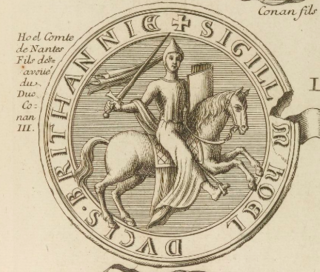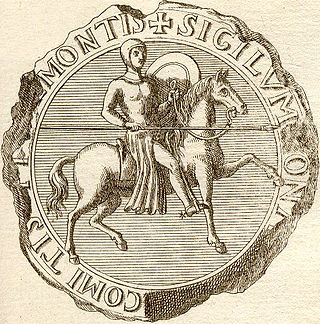Bertha, Duchess of Brittany
Last updatedBertha of Cornouaille (fl. 1125–56), also known as Bertha of Brittany (Breton : Berthe Breizh), was the Duchess of Brittany between 1148 until her death and Dowager Countess of Richmond. Bertha was the elder daughter of Conan III of Brittany by Maude, the illegitimate daughter of King Henry I of England. [1] She was the last member of the Breton house of Cornouaille to reign over Brittany.
Contents
Life
Bertha was the daughter of Duke Conan III of Brittany. She married the son of Stephen of Treguier, Alan the Black, [2] and she lived in England with Alan until his death in 1146. Alan would eventually become Earl of Richmond. On his deathbed, Conan III renounced Bertha's brother Hoel as heir [2] and designated Bertha as his heiress, Duchess of Brittany. [3]
Family
In her first marriage, by 1138, Bertha was married to Alan the Black. [lower-alpha 1]
Bertha and Alan had three children:
- Conan IV, b. 1138, their son and heir, as Duke of Brittany and Earl of Richmond [3]
- Constance, who married Alan III, Viscount of Rohan [5]
- Enoguen, abbess of St. Sulpice
Bertha married her second husband, Odo, Viscount of Porhoet, in about 1148. [2] [6] Bertha and Odo had three children:
- Geoffroy
- Adelaide (died in 1220), Abbess of Fontevrault, mistress of Henry II, King of England [7] [5]
- Alix [lower-alpha 2]
Succession
Bertha died between 1158 and 1164, and with her death the ducal throne passed to her son Conan. [lower-alpha 3]
Notes
- ↑ Alan the Black was Count of Penthièvre. He was created 1st Earl of Richmond by Stephen of England for his support against the dispossessed Empress Matilda during the English civil war. [4] The marriage between Bertha and Alan may have been intended to bring Brittany into the English civil war on the side of Stephen.
- ↑ Everard states Odo and Bertha had only one daughter, Adelaide. [5]
- ↑ War broke out between Bertha's son Conan IV, Duke of Brittany and her second husband Odo. Odo may have made a compact with his brother-in-law, Hoel of Nantes, to divide Brittany between them. However, in late 1156 Conan IV was able to defeat Odo and secure his maternal inheritance.
Related Research Articles

The Duchy of Brittany was a medieval feudal state that existed between approximately 939 and 1547. Its territory covered the northwestern peninsula of Europe, bordered by the Atlantic Ocean to the west, and the English Channel to the north. It was also less definitively bordered by the river Loire to the south, and Normandy, and other French provinces, to the east. The Duchy was established after the expulsion of Viking armies from the region around 939. The Duchy, in the 10th and 11th centuries, was politically unstable, with the dukes holding only limited power outside their own personal lands. The Duchy had mixed relationships with the neighbouring Duchy of Normandy, sometimes allying itself with Normandy, and at other times, such as the Breton-Norman War, entering into open conflict.
Constance was Duchess of Brittany from 1166 to her death in 1201 and Countess of Richmond from 1171 to 1201. Constance was the daughter of Duke Conan IV by his wife, Margaret of Huntingdon, a sister of the Scottish kings Malcolm IV and William I.

Odo of Rennes, Count of Penthièvre, was the youngest of the three sons of Duke Geoffrey I of Brittany and Hawise of Normandy, daughter of Richard I of Normandy. Eudon married Agnes of Cornouaille, the daughter of Alan Canhiart, Count of Cornouaille and sister of Hoel II, Duke of Brittany who was married in 1066 to Eudon's niece Hawise, Duchess of Brittany.
Hoël II was Count of Kernev, from 1058 as Hoël V. On the basis of his marriage to Hawise, Duchess of Brittany, in 1066, he became Duke of Brittany jure uxoris.

Alan IV was Duke of Brittany from 1072 until his abdication in 1112. He was also Count of Nantes and Count of Rennes. His parents were Duchess Hawise and Duke Hoel II. He is also known as Alan Fergant. Through his father, he was of the Breton House of Cornouaille dynasty. He was the last Breton-speaking Duke of Brittany.
Conan III, also known as Conan of Cornouaille and Conan the Fat was duke of Brittany, from 1112 to his death. He was the son of Alan IV, Duke of Brittany and Ermengarde of Anjou.

Hoèl of Cornwall was count of Nantes, from 1148 to his death. He was raised the son of Duke Conan III and Maud FitzRoy, an illegitimate daughter of King Henry I of England. However, he was disinherited by his father when on his death-bed, as Conan III claimed that Hoèl was illegitimate and no son of his. Bertha then became heiress to Duke Conan's lands in Brittany, while Hoèl was allowed to remain Count of Nantes. He was accused by St. Bernard of Clairvaux of having an incestuous affair with his sister Bertha.
Odo II, Count of Porhoet was the son of Geoffroy, Viscount de Porhoët, and his wife Hawise. He became Duke of Brittany in 1148, jure uxoris, upon his marriage to Bertha, Duchess of Brittany.

Conan IV, called the Young, was the Duke of Brittany from 1156 to 1166. He was the son of Bertha, Duchess of Brittany, and her first husband, Alan, Earl of Richmond. Conan IV was his father's heir as Earl of Richmond and his mother's heir as Duke of Brittany. Conan and his daughter Constance would be the only representatives of the House of Penthièvre to rule Brittany.

The now-extinct title of Earl of Richmond was created many times in the Peerage of England. The earldom of Richmond was initially held by various Breton nobles; sometimes the holder was the Breton duke himself, including one member of the cadet branch of the French Capetian dynasty. The historical ties between the Duchy of Brittany and this English earldom were maintained ceremonially by the Breton dukes even after England ceased to recognize the Breton dukes as earls of England and those dukes rendered homage to the King of France, rather than the English crown. It was then held either by members of the English royal families of Plantagenet and Tudor, or English nobles closely associated with the English crown. It was eventually merged into the English crown during the reign of Henry VII of England and has been recreated as a Dukedom.

Alan, 1st Earl of Richmond, Breton Alan Penteur, also known as "Alan the Black", was a Breton noble who fought for Stephen, King of England. Alan was the third son of Stephen, Count of Tréguier, and Hawise de Guingamp.
Stephen of Penthièvre, Count of Tréguier, 3rd Lord of Richmond was a Breton noble and a younger son of Odo, Count of Penthièvre and Agnes of Cornouaille, sister of Hoël II, Duke of Brittany. In 1093, he succeeded to the title of Count of Tréguier; in 1098, he succeeded his brother Alain as Lord of Richmond in Yorkshire, England.
The counts of Nantes were originally the Frankish rulers of the Nantais under the Carolingians and eventually a capital city of the Duchy of Brittany. Their county served as a march against the Bretons of the Vannetais. Carolingian rulers would sometimes attack Brittany through the region of the Vannetais, making Nantes a strategic asset. In the mid-ninth century, the county finally fell to the Bretons and the title became a subsidiary title of the Breton rulers. The control of the title by the Breton dukes figured prominently in the history of the duchy. The County of Nantes was given to Hoel, a disinherited son of a duke. He lost the countship due to a popular uprising. That uprising presented an opportunity for King Henry II of England to attack the Breton duke. In the treaty ending their conflicts, the Breton duke awarded the county to Henry II.
The noble Breton family line of Porhoët was a French noble family in the middle ages, from around 990 through the 1200's. Notable members included Odo I, Odo II, and Alan I. Alan I would go on to form the Franco-Breton House of Rohan, which survives to the modern day.

The Viscounty or County of Léon was a feudal state in extreme western Brittany in the High Middle Ages. Though nominally a vassal of the sovereign duke of Brittany, Léon was functionally independent of any external controls until the viscounts came under attack by King Henry II of England. It thus became the focus of revolts and wars when Brittany was drawn into the Angevin empire.
Hawise of Rennes was sovereign Duchess of Brittany from 1066 until her death.
Maud or Matilda Fitzroy, was a duchess consort of Brittany by her marriage to Conan III, Duke of Brittany. She was an illegitimate daughter of Henry I of England by one of his unknown mistresses.
Alain Canhiart was the count of Cornouaille from 1020 to 1058. He was the son of Benoît de Cornouaille and the father of Hoël II, Duke of Brittany. His family name, Canhiart, is understood to be derived from the old Breton Kann Yac'h and was translated into the Latin texts of his era as Bellator fortis.
Constance of Penthièvre was a Breton princess, daughter of Alan of Penthièvre, 1st Earl of Richmond, and Bertha of Cornouaille, suo jure Duchess of Brittany.
References
- ↑ Bryan 2016, p. 173.
- 1 2 3 Warren 1977, p. 75.
- 1 2 Everard 2004, p. 149.
- ↑ Cokayne, G. E., edited by H. A. Doubleday, Geoffrey H. White, & Lord Howard de Walden, The Complete Peerage, London, 1945, vol. x, p. 788.
- 1 2 3 Everard 2004, p. 46.
- ↑ Everard 2004, p. 32.
- ↑ Vincent 2007, p. 331.
References
- Bryan, Elizabeth J. (2016). "Matthew Parker and the Middle English Prose Brut". In Rajsic, Jaclyn; Kooper, Erik; Hoche, Dominique (eds.). The Prose Brut and Other Late Medieval Chronicles. York Medieval Press.
- Dunbabin, Jean (1985). France in the Making, 843-1180. Oxford University Press.
- Everard, J. A. (2004). Brittany and the Angevins: Province and Empire 1158–1203. Cambridge University Press.
- Vincent, Nicholas (2007). "The Court of Henry II". In Harper-Bill, Christopher; Vincent, Nicholas (eds.). Henry II: New Interpretations. The Boydell Press.
- Warren, Wilfred Lewis (1977). Henry II. Yale University Press.